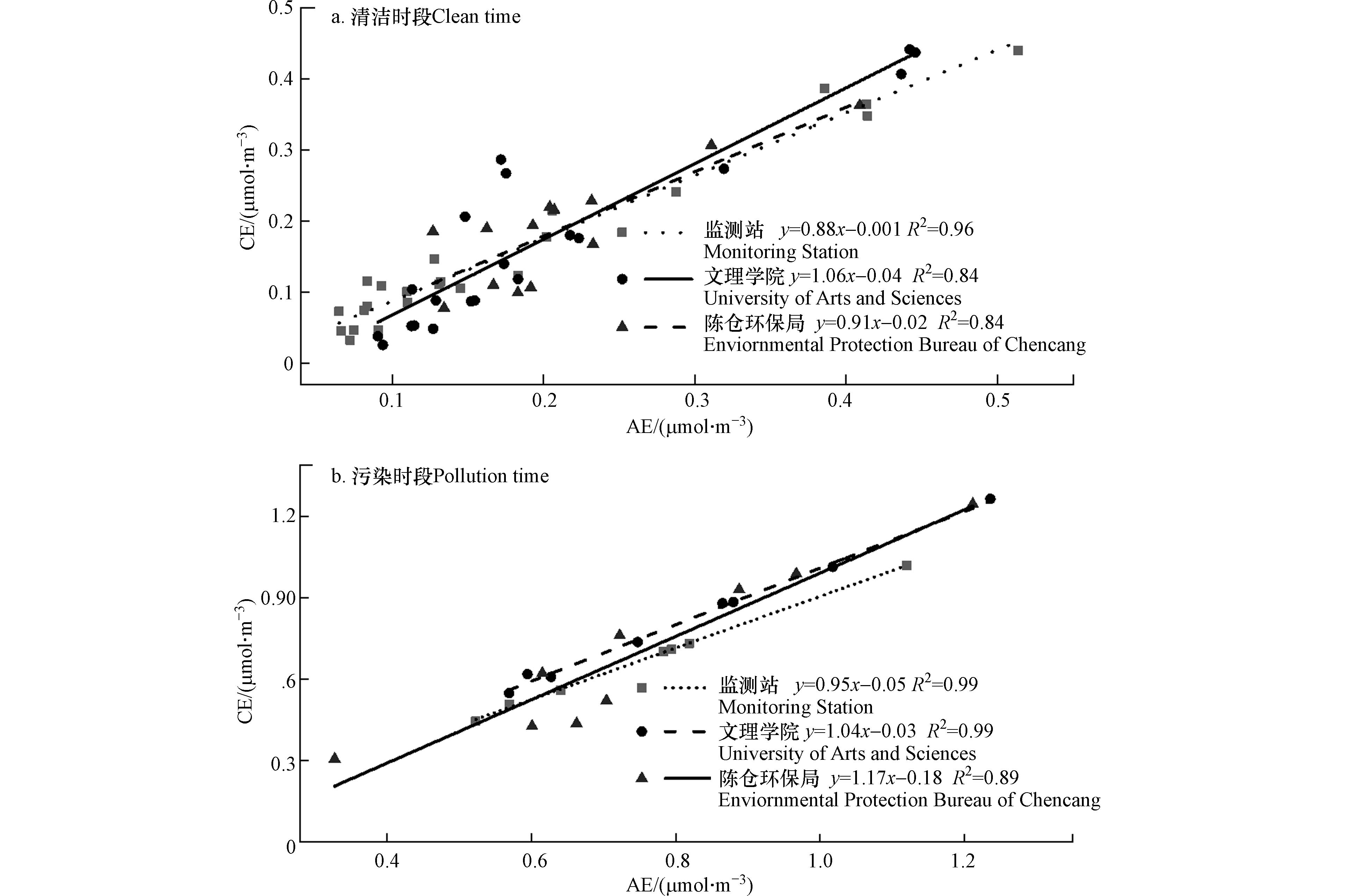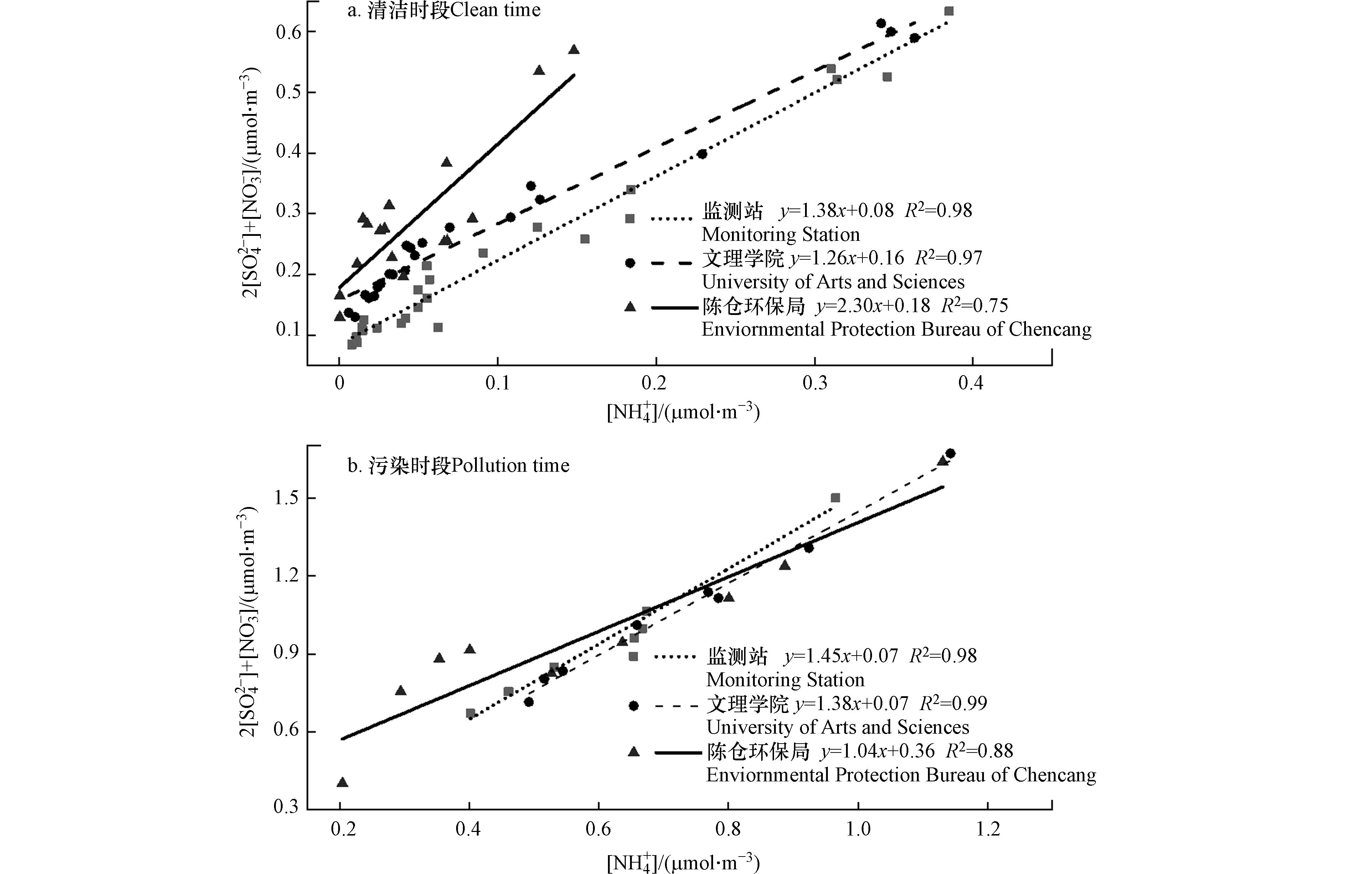-
2013年以来,有研究表明以PM2.5为首的大气污染过程在京津冀、汾渭平原和长三角等地区频繁发生[1-2],对我国生态环境,人体健康及社会经济造成巨大威胁[3-4]。目前,学者对大气PM2.5的研究主要集中在化学组分[5-6],污染成因和来源解析[7- 8]等方面。PM2.5的化学组分复杂,其中元素、碳质物和离子组分通常被测量以评估其对大气质量的不利影响及污染来源[9-12]。其中,水溶性粒离子质量浓度在PM2.5中的占比最高可达80%以上[13]。作为PM2.5的重要组分,其来源复杂,对颗粒物污染的形成具有重要驱动作用[14]。因此,研究PM2.5中水溶性离子浓度的变化特征对了解PM2.5污染物特征和来源具有重要意义。
水溶性无机离子主要成分是二次离子[5, 15],是造成城市大气能见度降低的主要原因[16],因受各地不同自然条件、能源结构及相关政策的影响,其质量浓度水平存在较大差异[17-18]。目前,很多学者通过研究大气中水溶性离子组成及季节变化特征,来了解颗粒物的形成和污染来源。 Wu等[19]研究得出,雾霾期和清洁期水溶性离子中NO3-、SO42−、NH4+占主导,新年烟花燃放期间,K+是最丰富的离子,其次是SO42−和Cl-,表明烟花燃烧可改变大气化学性质。Liu等[13]研究发现农民活动的周期性排放对北京市大气水溶性离子有显著贡献,同时密集的农业活动可导致区域沙尘。黄含含等[20]对西安市PM2.5中水溶性离子特征的研究表明,NO3-和NH4+质量浓度在秋冬季偏高,春夏季偏低,SO42−浓度春季最低,夏冬季较高,同时SNA在四季以不同的形式存在于大气中。
宝鸡市位于关中平原西部,南、西、北三面环山,典型的河谷地形及全年较大湿度等均不利于大气污染物的扩散,加之宝鸡市是我国重要的重工业城市,经济结构以工业为主。同时宝鸡市钛产业规模居全国之首、全球第二,被誉为“中国钛谷”,全市汽车产业总产值占全省三分之一,经济的迅速发展使得宝鸡市大气环境污染问题不容忽视。为了解宝鸡市大气颗粒物中水溶性离子的污染特征,对不同污染时段下水溶性离子的研究尤为必要。
本文研究宝鸡市秋季清洁时段和污染时段水溶性离子浓度水平,并结合后向轨迹和主成分分析-多元线性回归模型(PCA-MLR),阐明秋季PM2.5中水溶性离子的污染特征及来源,以期为宝鸡市进一步开展大气气溶胶研究提供基础数据,为制定PM2.5污染控制措施提供科学依据。
-
本研究根据城市功能区划及人口密度,选取3 个站点,自西向东依次为监测站(34.35°N,107.14°E)、文理学院(34.35°N,107.21°E)和陈仓环保局(34.36°N,107.35°E)。于2019年10月15日—11月14日,使用流速为16.7L·min−1的TH-16A仪器(武汉天虹)进行样品采集。监测站位于渭滨区,属于市区,北靠人民公园,周围以住宅区和公园绿地为主。文理学院位于高新区,属于文教区,北邻渭河,周围主要布局有教学楼、办公楼、居民区。陈仓环保局位于郊区,属于城乡结合部,距离宝鸡过境高速1.5 km,汽车保有量和过境车辆较多。3个站点具体位置均设置在楼顶的空地,样品采集距地面的高度约为20 m,站点周围地势开阔,均无明显的污染排放源。
PM2.5采集使用直径47 mm的石英滤膜。采样前需将滤膜放置于马弗炉中450 ℃高温烘烤6 h,去除表面的挥发组分和有机物,并将其置于温度为(20±2)℃,相对湿度为40%±5%的恒温箱中平衡24 h,随后使用精度为10 μg的天平(德国Sartorius BT125D 型)进行称量,至少称量两次,空白滤膜和样品滤膜连续两次称量的误差分别需小于20 μg和50 μg。每个样品采集时长约为23 h(当日10:00—次日9:00),采样时需注意滤膜完整无损,三站点仪器保持同时间开关。采样后的滤膜先放入恒温箱恒温24 h,其次称重后放入样品盒,置于冰箱(-18 ℃)中保存,待离子分析。
-
离子分析时,取每个样品滤膜的1/4放入15 mL溶样瓶中,加入10 mL去离子水(电阻率>18.2 MΩ),通过超声萃取1 h,摇床振荡1 h,结束后用5 ml针筒抽取上清液,并用0.45 μm过滤头过滤,将其置于专用的样品管中。使用Dionex-600型离子色谱仪对样品中的水溶性离子中的阳离子(NH4+、Ca2+、Mg2+、Na+和K+)和阴离子Cl-、NO3-和SO42-进行定量分析测量,操作步骤见文献[21]。用Chromeleon软件进行图谱分析,得到各水溶性离子组分的质量浓度。
-
ISORROPIA-Ⅱ模型是基于热力学原理,计算气溶胶含水量中氢离子的浓度[22]。该模型将同时段内水溶性离子质量浓度值和对应环境的温度和相对湿度作为输入数据,通过计算得到液相中H+浓度和水含量来计算气溶胶pH值。
$ {\mathrm{p}\mathrm{H}}_{\mathrm{i}\mathrm{s}} $ 计算公式如下:$ {\mathrm{式}\mathrm{中},\mathrm{p}\mathrm{H}}_{\mathrm{i}\mathrm{s}} $ 是PM2.5的酸度;$ {\gamma }_{{\mathrm{H}}^{+}} $ 是H+的活度系数(假设$ {\gamma }_{{\mathrm{H}}^{+}}=1 $ );$ {\mathrm{H}}_{\mathrm{a}\mathrm{i}\mathrm{r}}^{+} $ 是单位体积空气中平衡颗粒水合氢离子的浓度,ALWC是PM2.5的含水量,$ {\mathrm{H}}_{\mathrm{a}\mathrm{i}\mathrm{r}}^{+} $ 和ALWC是利用ISORROPIA-Ⅱ模型计算得出,单位均为μg·m−3。 -
利用SPSS软件对宝鸡市秋季清洁和污染时段大气PM2.5中的水溶性离子污染来源进行主成分分析(PCA),其次利用多元线性回归模型(MLR)得出污染源的平均贡献率[23-24]。MLR模型方程如下:
式中,Y为标准化后PM2.5中总水溶性离子质量浓度,
$ {X}_{i} $ 为主成分的因子得分变量,$ {B}_{i} $ 为MLR的回归系数。源$ i $ 的平均贡献率(Z,%)计算公式为: -
后向轨迹图形轨迹制作利用(HYSPLIT) 模式,根据气流在垂直和水平方向上的运动速率和方向进行聚类,可反映一段时间内到达目标地区气流的大致轨迹来向及不同来向占比,目前已广泛应用于大气化学观测数据分析[25-26]。本研究监测时段采用GDAS气象数据,模拟起始高度设置为500 m,每隔6 h计算1次,每条轨迹时长为24 h,使用TrajStat进行轨迹聚类[27]。采用欧拉距离法,得到气团后向轨迹聚类,并对各传输类型气团输送轨迹所对应的PM2.5及水溶性离子质量浓度进行统计分析。
-
2019年宝鸡市秋季PM2.5平均质量浓度为(57.8±6.3)μg·m−3,低于国家空气质量二级标准值(GB 3095—2012,75 μg·m−3)。图1为3个站点采样期间PM2.5质量浓度的变化趋势图,从时间特征来看,三站点PM2.5变化趋势基本一致,在10月18日—10月22日和11月4日—11月8日两时段内,均出现了峰值,可能受该时段内较大湿度和较小风速的影响。从空间特征来看:PM2.5的平均质量浓度水平从高到低为:陈仓区环保局((65.4±31.2)μg·m−3)>文理学院((58.1±31.5) μg·m−3)>宝鸡市监测站((49.9±30.1)μg·m−3)。陈仓区环保局污染水平较高,可能由于陈仓环保局属于城乡结合部,会受当地居民的生活习惯进行燃煤,生物质燃烧的影响。
为了解不同污染状况下大气的污染特征,本研究根据《环境空气质量指数(AQI)技术规定》标准,按照PM2.5日均质量浓度值将污染情况分为清洁时段(PM2.5≤75 μg·m-3)和污染时段(PM2.5>75 μg·m−3)[28]。清洁时段和污染时段PM2.5平均质量浓度分别为40.0 μg·m−3和100.1 μg·m−3,污染时段其质量浓度超出二级标准的33.5%,是清洁时段的2.5倍。清洁时段、污染时段的相对湿度和风速分别为72.4%、84%和0.9 m·s−1、0.6 m·s−1。湿度较大,可促进颗粒物吸湿增长,从而使得PM2.5的浓度升高。同时水溶性离子的质量浓度也随着PM2.5的升高而升高。
-
三站点秋季水溶性离子平均质量浓度如表1所示,各离子的质量浓度水平由高到低顺序是:NO3->SO42−>NH4+>Ca2+>Na+>Cl->K+>Mg2+。陈仓环保局总水溶性离子浓度最高,平均质量浓度为(29.2±4.5) μg·m3,其次是文理学院和监测站,分别为(27.4±4.3) μg·m−3和(22.4±3.6) μg·m−3。宝鸡市秋季三站点总水溶性离子(TWSI)平均质量浓度与2012年同时段相比减少了37.5%,各水溶性离子质量浓度均明显减少,NO3-、SO42−、NH4+、Ca2+、Na+、Cl-、K+和Mg2+分别减少了9.2%、54.9%、31.3%、63.6%、46.2%、73.1%、70.0%和50.0%。说明采取清洁取暖和清洁生产的污染减排措施成果显著。
在清洁时段和污染时段三站点水溶性离子平均质量浓度分别为:(13.7±7.7)μg·m−3和(57.8±15.0) μg·m−3, 污染时段是清洁时段的4.2倍。清洁和污染时段三站点NO3-质量浓度最高,SO42−和NH4+次之。由表23个站点清洁时段和污染时段SNA浓度水平及占比可得:3个站点清洁时段和污染时段NO3-、SO42−、NH4+平均质量浓度分别为(6.3±4.7)μg·m−3、(4.1±1.4) μg·m−3、(1.5±1.5) μg·m−3和(31.6±7.3)μg·m−3、(13.1±3.6)μg·m−3、(11.6±5.0)μg·m−3,污染加重,其浓度分别增加5、3、7倍。此期间,SNA占总水溶性离子质量浓度的90.0%,Ca2+、Na+、Cl-、K+和Mg2+仅占9.0%,其中SNA占比低于典型工业城市河北石家庄市(91.5%±17.3%)[30],但高于汉中市(86.6%)[31]、北京市(74.6%)[32]和郑州市(82.5%)[33],说明宝鸡市秋季大气受二次污染影响较大。SNA平均质量浓度在清洁时段为(11.9±2.0)μg·m−3,污染时段其质量浓度为(56.3±9.1)μg·m−3,增加约5倍,随着污染加重SNA占PM2.5浓度的由27.9%增加到54.7%,占总水溶性离子质量浓度比值由81.1%增加到95.1%。且污染越重,SNA质量浓度越大,占总离子和PM2.5的比例也越大。3个站点SNA占总离子的平均比例为90.1%,与2012年同时段相比占比增高,说明总水溶性离子的质量浓度虽有所降低,但SO2、NOx和NH3等前体物的二次反应对大气污染仍有重要影响。
NO3-/SO42−通常表示移动源和燃煤源的贡献特征[34]。监测站、文理学院和陈仓环保局观测期间NO3-/SO42−值分别为1.7、1.8和1.6。清洁时段三站点NO3-/SO42−值分别为1.3、1.6和1.4,陈仓环保局的比值相对其他两站点小。同时,由表2可知陈仓环保局SO42−质量浓度在清洁时段较其他两站点高,而SO42−主要来源于煤和石油等的燃烧[35],说明陈仓环保局在清洁时段固定源对PM2.5的贡献相较其他两站点更为显著。在污染时段三站点的比值分别为2.5、2.5和2.4,是清洁时段的1.6—1.8倍。有研究表明[36],硫氧化率和氮氧化率随湿度的增加不断升高,当湿度大于70%时氮氧化率随湿度增加降低,污染时段大气相对湿度(77.4%)大于清洁时段(66.3%)。NO3-主要通过汽车尾气排放的NOx经非均相氧化反应生成[37],说明污染加重,移动源的影响更为明显。清洁时段和污染时段三站点NO3-/SO42−值均大于1,是2012年的近2倍,2019年汽车保有量(39.49万)[38]是2012年(16.99万)[39]的2.3倍,说明相比2012年,目前宝鸡市大气污染受移动源的影响较大。
-
大气颗粒物的酸碱性对降水的pH值有非常重要的影响,它能引起降水的酸化,同时也可能对酸性的降水起到中和作用[16]。有研究表明,SO42−、NO3-、F-和Cl-等阴离子可增加颗粒物的酸性[40],相反阳离子可增加颗粒物的碱性。通常用阴离子和阳离子的电荷当量比值(AE/CE)来推断气溶胶的酸性[40-41]。阴离子电荷当量AE和阳离子电荷当量CE计算公式为:
式中,ρ指离子的质量浓度(μg·m−3),AE和CE分别为阴离子和阳离子电荷当量浓度(μmol·m−3)
观测期间阴阳离子平衡情况如图2所示,可看出清洁时段和污染时段3个采样点的阴阳离子平衡的相关系数较高,说明宝鸡市秋季污染来源相对较稳定。3个站点AE/CE值均接近于1,说明PM2.5整体偏中性。但随着污染加重,监测站和陈仓环保局站点线性拟合斜率增大,说明阴离子有亏损,颗粒物碱性增强。此外,利用热力学模型ISORROPIA-II对各站点PM2.5的酸度(pHis)和含水量进行计算,监测站、文理学院、陈仓环保局站点的pHis值分别为2.3±1.1、2.6±1.9和2.1±1.1,表明采样期间酸性强度:陈仓环保局>监测站>文理学院。陈仓区PM2.5酸度较其他两站点高,这可能与其周边村民燃煤生活方式有关。宝鸡市秋季清洁时段和污染时段的pHis值分别为2.6±0.7和2.7±0.5,说明污染加重,PM2.5的碱性增强,但其变化不明显。进一步研究发现,清洁时段和污染时段含水量分别为(8.2±8.6)μg·m−3、(64.4±30.5)μg·m−3,污染时段的含水量是清洁时段的7.9倍,含水量的增加,对颗粒物的酸碱性有一定调节作用[42]。
-
为了解宝鸡市大气PM2.5中的各水溶性离子间存在的潜在联系,并进一步推断其结合方式,对PM2.5及其水溶性离子组分进行相关分析,结果如表3所示,PM2.5与SNA呈显著正相关(R2>0.95),说明二次离子对PM2.5的形成有重要影响。PM2.5与一次离子(Cl-、K+、Na+和Ca2+)呈正相关,与Cl-和K+的相关性较高,说明燃煤和生物质燃烧对其贡献较大[43]。
NO3-、SO42−和NH4+三者相关性较高,NH4+通常会优先与SO42−反应生成(NH4)2SO4或NH4HSO4,剩余的NH4+和NO3−反应生成NH4NO3[33]。 当NH4+和 SO42−摩尔浓度比值大于2时,则SO42−与 NH4+充分反应生成(NH4)2SO4,而非NH4HSO4[32]。清洁时段和污染时段监测站、文理学院、陈仓环保局三站点的NH4+与SO42−摩尔浓度的比值分别为1.2、0.9、0.5和2.5、2.7、2.2,说明SO42−与 NH4+在清洁时段和污染时段分别以NH4HSO4和(NH4)2SO4的形式存在。为了进一步探究站点清洁和污染时段SNA存在的形式,绘制了2[SO42−]+[NO3-]与[NH4+]的摩尔浓度散点及线性拟合图,如图3所示,3个站点在清洁时段和污染时段2[SO42−]+[NO3-]与[NH4+]拟合斜率均大于1,说明NH4+与SO42−和NO3-反应后,NO3-有剩余,可知SNA在清洁时段主要以NH4HSO4形式存在,污染时段主要以(NH4)2SO4和NH4NO3的形式存在,而清洁和污染时段过剩的NO3-便可与其他阳离子结合。
-
为了解宝鸡市秋季水溶性离子来源,利用PCA-MLR模型分析,结果如表4所示。清洁时段,通过分析确定了3种因子,其累计解释方差为86.1%。PC1方差解释比为39.2%,该主成分中SO42−、NO3-和NH4+的载荷值较高,SO42−、NO3-、NH4+主要通过污染气体二次转化得到,PC1代表二次生成源。PC2的方差解释比例为25.4%,Cl-是燃煤的标志[5],Mg2+和Ca2+均为地壳元素的标志物[17],Na+的主要来源有海盐离子和道路扬尘[44], PC2可识别为燃煤和扬尘的混合源。PC3的方差解释比例为21.5%,K+为生物质燃烧的标志[45],识别为生物质燃烧源。污染时段,确定了两种因子,累计解释方差为81.6%,PC1方差解释比为57.5%,该主成分中SO42−、NO3-、NH4+、Cl-和K+载荷值较高,表征了二次生成、燃煤和生物质燃烧的混合源。PC2方差解释比为24.1%,Ca2+、Na+和Mg2+载荷值较高,其主要来源于扬尘,识别为扬尘源。
利用SPSS软件进行多元线性回归,得到清洁时段和污染时段线性回归方程分别为:
清洁时段:
$ Y=0.84\mathrm{F}1+0.41\mathrm{F}2+0.12\mathrm{F}3\mathrm{ }\mathrm{ }\mathrm{ }\mathrm{ }({R}^{2}=0.89,P=0.00) $ 污染时段:
$ Y=0.998\mathrm{F}1+0.008\mathrm{F}2\mathrm{ }\mathrm{ }\mathrm{ }\mathrm{ }({R}^{2}=0.99,P=0.00) $ 式中,
$ {F}_{i} $ 为源$ i $ 的因子得分变量,P为显著性水平,检测值均符合0<P<0.05,故自变量和因变量之间存在线性关系。利用公式(3)计算得出宝鸡市秋季清洁时段,二次生成、燃煤扬尘混合源和生物质燃烧的贡献率分别为61.3%、29.8%和8.9%。污染时段,二次生成及燃烧混合源和扬尘源的贡献率分别为99.2%和0.8%。可知秋季污染主要受二次气溶胶和燃烧源的影响,控制二次离子转化的前体物(SO2、NO2、NH3)的排放,生物质燃烧及化石燃料的燃烧对改善宝鸡市空气质量具有重要意义。
图4(a)为监测期间到达宝鸡市的气团聚类结果,图4(b)为清洁时段和污染时段各轨迹上水溶性离子的质量浓度(左为清洁时段,右为污染时段,轨迹3仅为清洁时段)。由图4知,监测期间轨迹聚类结果分为4类,且污染时段各轨迹上PM2.5中水溶性离子的质量浓度高于清洁时段。其轨迹1(52.34%)起源于汉中市附近,携带PM2.5浓度最高,为61.3 μg·m3,其次轨迹4(23.44%)起源于甘肃省东部的平凉地区,PM2.5浓度为48.1 μg·m−3。此两类气流占总气流的75.78%。轨迹2(9.38%)和轨迹3(14.84%)分别起源于甘肃中部和内蒙古西南部,均来源于西北方向,经宁夏,甘肃西部到达宝鸡,携带PM2.5浓度分别为48.1 μg·m3和40.7 μg·m3,共占总气流比例为23.22%,相比轨迹4和轨迹1距离更远,占比小,携带污染物浓度小,说明宝鸡市秋季大气污染主要为本地及其周边的输送,远距离传输的影响较小。
-
(1)宝鸡市秋季三站点PM2.5平均质量浓度(57.8±6.3) μg·m−3,陈仓环保局PM2.5质量浓度较其它两站点高。污染时段和清洁时段PM2.5平均质量浓度分别为40.0 μg·m−3和100.1 μg·m−3,污染时段质量浓度超出二级标准的33.5%,是清洁时段的2.5倍。
(2)污染时段总水溶性离子质量浓度是清洁时段的3—7倍,清洁和污染时段NO3-质量浓度均为最高,SO42−和NH4+次之。SNA在TWSIs中的平均占比为90.0%,污染越重,SNA质量浓度越大,占TWSIs和PM2.5的比例也越大。污染时段三站点NO3−/SO42−值相较清洁时段增加1.6—1.8 倍。
(3)秋季大气PM2.5整体偏中性,清洁时段和污染时段的pHis值分别为2.6±0.7和2.7±0.5,污染加重,碱性增强。SNA在清洁时段主要以NH4HSO4形式存在,污染时段主要以(NH4)2SO4和NH4NO3的形式存在。
(4)PCA-MLR分析得知:秋季大气污染主要来源有二次生成源、燃烧源和扬尘源,污染时段二次气溶胶和燃烧源占主导地位,贡献率达到99.2%。轨迹聚类结果得知,污染时段各轨迹上水溶性离子的质量浓度均高于清洁时段,污染主要来源于本地及周边地方的传输。
致谢:感谢宝鸡市一市一策组的支持!
宝鸡市秋季清洁和污染时段水溶性离子污染特征及来源解析
Characteristics and sources of water-soluble ion pollution during cleaning and pollution periods in Baoji City in autumn
-
摘要: 为探究宝鸡市秋季大气PM2.5中水溶性离子的污染特征及来源,于2019年10月15日至11月14日分别对宝鸡市监测站、文理学院和陈仓区环保局的3个站点进行PM2.5样品采集,通过离子色谱仪得到水溶性离子质量浓度,分析了3个站点水溶性离子在清洁时段和污染时段的变化特征及来源。结果表明,三站点PM2.5的质量浓度陈仓区环保局>文理学院>宝鸡市监测站。清洁时段和污染时段PM2.5平均质量浓度分别为40.0 μg·m−3和100.1 μg·m−3,水溶性离子平均质量浓度分别为(13.7±7.7)μg·m−3和(57.8±15.0)μg·m−3。污染时段NO3−/SO42−值是清洁时段的1.6—1.8倍。污染越重,SNA(NO3−、SO42−和NH4+)质量浓度越大,占总水溶性离子和PM2.5的比例也越大。清洁时段,SNA主要以NH4HSO4形式存在,污染时段主要以(NH4)2SO4和NH4NO3的形式存。秋季大气PM2.5整体偏中性,污染加重,碱性加强。PCA-MLR模型分析得知,秋季水溶性离子污染主要来源有二次生成源、燃煤燃烧源和扬尘源,清洁时段主要污染来源为二次生成源,贡献率为61.3%,污染时段主要来源于二次生成及燃烧混合源,贡献率达到99.2%。轨迹聚类结果得出污染源主要为本地及周边传输。Abstract: In order to explore the pollution characteristics and sources of water-soluble ions in autumn atmospheric PM2.5 in Baoji City, and to study the difference between cleaning period and pollution period, PM2.5 samples were collected from Baoji Monitoring Station, College of Arts and Sciences and Chencang Environmental Protection Bureau from October 15, 2019 to November 14, 2019 and analyzed for water-soluble ions by ion chromatography. The variation characteristics and emission sources of water-soluble ions at the three sites during cleaning period and pollution period were then investigated. The results showed that the average concentration of PM2.5 in the three stations was 40.0 μg·m−3 and 100.1 μg·m−3 in the pollution period and clean period, respectively, at the > College of Arts and Sciences, Chencang District Environmental Protection Bureau, Baoji City. The average mass concentrations of water-soluble ions were(13.7±7.7)μg·m−3 and (57.8±15.0)μg·m−3 at the cleaning period and the pollution period, respectively. NO3− concentration was the highest at different periods, followed by SO42− and NH4+. The NO3−/SO42− values at the three stations during the polluted period increased by 1.6-1.8 times compared with the clean period. The heavier the pollution, the greater the mass concentration of SNA, and the greater the proportion of SNA in TWSIS and PM2.5. During the cleaning period, SNA mainly exists in the form of NH4HSO4, while during the pollution period, SNA mainly exists in the form of (NH4)2SO4 and NH4NO3.During the observation period, the overall atmospheric PM2.5 was neutral, pollution increased and acidity decreased slightly. PCA-MLR model analysis showed that the main sources of water-soluble ion pollution in autumn were secondary conversion, combustion and dust sources. The main pollution source in clean period was secondary generation source, with a contribution rate of 61.3%. The main pollution source in pollution period was secondary generation and combustion mixed sources, with an average contribution rate of 99.2%. According to the result of track clustering, the pollution is mainly caused by local and surrounding transportation.
-
Key words:
- Baoji /
- water-soluble ion /
- trajectory clustering /
- source apportionment
-

-
表 1 秋季大气PM2.5及水溶性离子质量浓度(μg·m−3)
Table 1. Atmospheric PM2.5 and water-soluble ion mass concentration in autumn
站点site NO3- SO42- NH4+ Ca2+ Na+ Cl- K+ Mg2+ TWSI PM2.5 监测站 11.1±11.7 5.4±4.3 4.1±4.6 0.4±0.3 0.4±0.1 0.7±0.3 0.3±0.1 0.1 22.4±3.6 49.9±30.1 文理学院 13.5±13.0 6.6±4.7 4.8±5.7 0.9±0.7 0.8±0.6 0.4±0.3 0.3±0.2 0.2±0.1 27.4±4.3 58.1±31.5 陈仓环保局 14.0±12.6 7.3±4.4 4.3±5.5 1.2±0.6 0.9±0.4 0.9±0.3 0.4±0.2 0.1±0.1 29.2±4.5 65.4±31.2 平均值 12.9±1.3 6.4±0.8 4.4±0.3 0.8±0.3 0.7±0.2 0.7±0.2 0.3 0.1 26.2±2.7 57.8±6.3 2012年秋季[29] 14.2±1.9 14.2±0.7 6.4±0.9 2.2±0.1 1.3±0.2 2.6±1.2 1.0±0.1 0.2±0.1 41.9±5.2 — 表 2 三站点清洁时段和污染时段SNA浓度水平及占比
Table 2. Concentration levels and proportions of SNA in cleaning period and pollution period of the three stations
污染等级
Class of pollution站点
Site离子质量浓度/(μg·m−3) Ion mass concentration (SNA/PM2.5)/% (SNA/ WSIIs)/% NO3-/SO42− NO3- SO42- NH4+ SNA 清洁时段 监测站 5.3±5.0 3.3±1.5 1.7±1.7 10.3±1.5 29.4 80.0 1.4 文理学院 7.0±5.0 4.1±1.5 1.8±2.0 12.9±2.1 31.5 84.5 1.6 陈仓环保局 6.7±4.2 4.9±1.3 1.1±0.9 12.7±2.3 26.5 78.8 1.3 平均值 6.3±4.7 4.1±1.4 1.5±1.5 11.9±2.0 29.1 81.1 1.4 污染时段 监测站 29.1±7.1 12.0±3.6 11.2±3.1 51.3±8.5 54.1 95.8 2.5 文理学院 33.9±7.9 13.9±3.9 13.7±3.7 61.5±9.5 57.9 95.6 2.5 陈仓环保局 31.9±7.6 13.5±3.7 12.2±4.7 57.6±9.0 53.6 94.0 2.4 平均值 31.6±7.3 13.1±3.6 11.6±5.0 56.3±9.1 55.2 95.1 2.4 2019秋季 三站点平均 12.9±1.3 6.4±0.8 4.4±0.3 23.7±2.2 41.0 90.1 2.0 2012秋季[29] 平均值 14.2±1.9 14.2±0.7 6.4±0.9 34.8±3.7 — 83.1 1.0 表 3 PM2.5及水溶性离子的相关系数矩阵
Table 3. Correlation coefficient matrix of PM2.5 and water-soluble ions
SO42− NO3− Cl− NH4+ Na+ K+ Mg2+ Ca2+ PM2.5 SO42− 1 NO3− 0.952** 1 Cl− 0.653** 0.612** 1 NH4+ 0.979** 0.986** 0.645** 1 Na+ 0.005 0.024 0.335* −0.014 1 K+ 0.825** 0.829** 0.684** 0.842** 0.208 1 Mg2+ −0.307 −0.180 0.050 −0.240 0.477** −0.266 1 Ca2+ 0.034 −0.017 0.407* 0.011 0.474** 0.327 0.085 1 PM2.5 0.951** 0.964** 0.721** 0.966** 0.109 0.916** −0.207 0.170 1 **表示在置信度P<0.01时,相关性显著;*表示置信度P<0.05,相关性显著.
** indicates that the correlation is significant when the confidence is P<0.01; * represents confidence P<0.05, indicating significant correlation.表 4 PM2.5中水溶性离子因子载荷矩阵
Table 4. Water soluble ion factor load matrix in PM2.5
离子组分
Ion components清洁时段Clean time 污染时段Pollution time PC1 PC2 PC3 PC1 PC2 SO42- 0.92 −0.14 0.18 0.84 −0.24 NO3- 0.90 −0.32 −0.04 0.998 0.02 Cl- 0.19 0.74 0.38 0.92 0.20 NH4+ 0.93 −0.32 0.04 0.95 −0.30 Na+ 0.55 0.62 −0.46 −0.16 0.86 K+ 0.49 −0.11 0.76 0.96 −0.11 Mg2+ 0.58 0.48 −0.57 0.21 0.59 Ca2+ −0.003 0.71 0.50 0.39 0.80 特征值 3.53 1.82 1.54 4.78 1.75 方差贡献率/% 39.2 25.4 21.5 57.5 24.1 累积方差贡献率/% 39.2 64.6 86.1 57.5 81.6 污染来源 二次生成 燃煤+扬尘 生物质燃烧 二次生成+燃烧 扬尘 贡献率 61.3% 29.8% 8.9% 99.2% 0.8% -
[1] 王跃思, 张军科, 王莉莉, 等. 京津冀区域大气霾污染研究意义、现状及展望 [J]. 地球科学进展, 2014, 29(3): 388-396. doi: 10.11867/j.issn.1001-8166.2014.03.0388 WANG Y S, ZHANG J K, WANG L L, et al. Researching significance, status and expectation of haze in Beijing-Tianjin-Hebei region [J]. Advances in Earth Science, 2014, 29(3): 388-396(in Chinese). doi: 10.11867/j.issn.1001-8166.2014.03.0388
[2] ZHENG G J, DUAN F K, SU H, et al. Exploring the severe winter haze in Beijing: The impact of synoptic weather, regional transport and heterogeneous reactions [J]. Atmospheric Chemistry and Physics, 2015, 15(6): 2969-2983. doi: 10.5194/acp-15-2969-2015 [3] MAJI K J, YE W F, ARORA M, et al. PM2.5 related health and economic loss assessment for 338 Chinese cities[J]. Environment International, 2018, 121(Pt 1): 392-403. [4] LIU F, TAN Q W, JIANG X, et al. Effects of relative humidity and PM2.5 chemical compositions on visibility impairment in Chengdu, China [J]. Journal of Environmental Sciences, 2019, 86: 15-23. doi: 10.1016/j.jes.2019.05.004 [5] HUANG F, ZHOU J B, CHEN N, et al. Chemical characteristics and source apportionment of PM2.5 in Wuhan, China [J]. Journal of Atmospheric Chemistry, 2019, 76(3): 245-262. doi: 10.1007/s10874-019-09395-0 [6] LI X R, WANG Y S, GUO X Q, et al. Seasonal variation and source apportionment of organic and inorganic compounds in PM2.5 and PM10 particulates in Beijing, China [J]. Journal of Environmental Sciences, 2013, 25(4): 741-750. doi: 10.1016/S1001-0742(12)60121-1 [7] LIU X Y, WANG M S, PAN X L, et al. Chemical formation and source apportionment of PM2.5 at an urban site at the southern foot of the Taihang mountains [J]. Journal of Environmental Sciences, 2021, 103: 20-32. doi: 10.1016/j.jes.2020.10.004 [8] 王德羿, 王体健, 韩军彩, 等. “2+26”城市大气重污染下PM2.5来源解析 [J]. 中国环境科学, 2020, 40(1): 92-99. doi: 10.3969/j.issn.1000-6923.2020.01.010 WANG D Y, WANG T J, HAN J C, et al. Source apportionment of PM2.5 under heavy air pollution conditions in “2+26” cities [J]. China Environmental Science, 2020, 40(1): 92-99(in Chinese). doi: 10.3969/j.issn.1000-6923.2020.01.010
[9] SHEN Z X, SUN J, CAO J J, et al. Chemical profiles of urban fugitive dust PM2.5 samples in Northern Chinese cities [J]. Science of the Total Environment, 2016, 569/570: 619-626. doi: 10.1016/j.scitotenv.2016.06.156 [10] 周变红, 王锦, 曹夏, 等. 宝鸡市冬季PM2.5中元素污染特征及健康风险评估 [J]. 生态毒理学报, 2020, 15(4): 299-311. ZHOU B H, WANG J, CAO X, et al. Characteristics and health risk assessments of elements in PM2.5 during winter in Baoji city [J]. Asian Journal of Ecotoxicology, 2020, 15(4): 299-311(in Chinese).
[11] 曹夏, 周变红, 王锦, 等. 西安城区黑碳气溶胶的污染特征及来源解析 [J]. 环境化学, 2020, 39(11): 3072-3082. doi: 10.7524/j.issn.0254-6108.2020061501 CAO X, ZHOU B H, WANG J, et al. Characteristics and source analysis of black carbon aerosol in Xi'an Urban Area [J]. Environmental Chemistry, 2020, 39(11): 3072-3082(in Chinese). doi: 10.7524/j.issn.0254-6108.2020061501
[12] HAN X K, GUO Q J, LIU C Q, et al. Effect of the pollution control measures on PM2.5 during the 2015 China Victory Day Parade: Implication from water-soluble ions and sulfur isotope [J]. Environmental Pollution, 2016, 218: 230-241. doi: 10.1016/j.envpol.2016.06.038 [13] LIU P F, ZHANG C L, MU Y J, et al. The possible contribution of the periodic emissions from farmers' activities in the North China Plain to atmospheric water-soluble ions in Beijing [J]. Atmospheric Chemistry and Physics, 2016, 16(15): 10097-10109. doi: 10.5194/acp-16-10097-2016 [14] TIAN M, LIU Y, YANG F M, et al. Increasing importance of nitrate formation for heavy aerosol pollution in two megacities in Sichuan Basin, southwest China [J]. Environmental Pollution, 2019, 250: 898-905. doi: 10.1016/j.envpol.2019.04.098 [15] 张棕巍, 胡恭任, 于瑞莲, 等. 厦门市大气PM2.5中水溶性离子污染特征及来源解析 [J]. 中国环境科学, 2016, 36(7): 1947-1954. doi: 10.3969/j.issn.1000-6923.2016.07.004 ZHANG Z W, HU G R, YU R L, et al. Characteristics and sources apportionment of water-soluble ions in PM2.5 of Xiamen City, China [J]. China Environmental Science, 2016, 36(7): 1947-1954(in Chinese). doi: 10.3969/j.issn.1000-6923.2016.07.004
[16] 郑敬茹, 瞿厚淑, 付山, 等. 黄石市大气PM2.5中水溶性离子浓度特征及来源分析 [J]. 环境科学研究, 2019, 32(7): 1170-1178. ZHENG J R, QU H S, FU S, et al. Characteristics and source analysis of water-soluble inorganic ions in PM2.5 in Huangshi city [J]. Research of Environmental Sciences, 2019, 32(7): 1170-1178(in Chinese).
[17] 王念飞, 陈阳, 郝庆菊, 等. 苏州市PM2.5中水溶性离子的季节变化及来源分析 [J]. 环境科学, 2016, 37(12): 4482-4489. WANG N F, CHEN Y, HAO Q J, et al. Seasonal variation and source analysis of the water-soluble inorganic ions in fine particulate matter in Suzhou [J]. Environmental Science, 2016, 37(12): 4482-4489(in Chinese).
[18] ZHOU J B, XING Z Y, DENG J J, et al. Characterizing and sourcing ambient PM2.5 over key emission regions in China Ⅰ: Water-soluble ions and carbonaceous fractions [J]. Atmospheric Environment, 2016, 135: 20-30. doi: 10.1016/j.atmosenv.2016.03.054 [19] WU C, WANG G H, WANG J Y, et al. Chemical characteristics of haze particles in Xi'an during Chinese Spring Festival: Impact of fireworks burning [J]. Journal of Environmental Sciences, 2018, 71: 179-187. doi: 10.1016/j.jes.2018.04.008 [20] 黄含含, 王羽琴, 李升苹, 等. 西安市PM2.5中水溶性离子的季节变化特征 [J]. 环境科学, 2020, 41(6): 2528-2535. HUANG H H, WANG Y Q, LI S P, et al. Seasonal variation of water-soluble ions in PM2.5 in Xi'an [J]. Environmental Science, 2020, 41(6): 2528-2535(in Chinese).
[21] ZHANG T. , CAO J J, TIE X X, et al. Water-soluble ions in atmospheric aerosols measured in Xi'an, China: Seasonal variations and sources [J]. Atmospheric Research, 2011, 102(1-2): 110-119. doi: 10.1016/j.atmosres.2011.06.014 [22] NENES A, PANDIS S N, PILINIS C. ISORROPIA: A new thermodynamic equilibrium model for multiphase multicomponent inorganic aerosols [J]. Aquatic Geochemistry, 1998, 4(1): 123-152. doi: 10.1023/A:1009604003981 [23] YANG B, ZHOU L L, XUE N D, et al. Source apportionment of polycyclic aromatic hydrocarbons in soils of Huanghuai Plain, China: Comparison of three receptor models [J]. Science of the Total Environment, 2013, 443: 31-39. doi: 10.1016/j.scitotenv.2012.10.094 [24] 衣雅男, 侯战方, 孟静静, 等. 聊城市冬季PM2.5中水溶性化合物的昼夜变化特征及来源解析 [J]. 环境科学, 2019, 40(10): 4319-4329. YI Y N, HOU Z F, MENG J J, et al. Diurnal variations and source analysis of water-soluble compounds in PM2.5 during the winter in Liaocheng city [J]. Environmental Science, 2019, 40(10): 4319-4329(in Chinese).
[25] 别淑君, 杨凌霄, 高颖, 等. 济南市背景区域大气PM2.5污染特征及其对能见度的影响 [J]. 环境科学, 2019, 40(9): 3868-3874. BIE S J, YANG L X, GAO Y, et al. Characteristics of atmospheric PM2.5 pollution and its influence on visibility in background areas of Ji'nan [J]. Environmental Science, 2019, 40(9): 3868-3874(in Chinese).
[26] 丁新航, 梁越, 肖化云, 等. 太原市采暖季清洁天与灰霾天PM2.5中水溶性无机离子组成及来源分析 [J]. 环境化学, 2019, 38(6): 1356-1366. doi: 10.7524/j.issn.0254-6108.2018121102 DING X H, LIANG Y, XIAO H Y, et al. Composition and source analysis of water-soluble inorganic ions of PM2.5 in clean and haze days during heating season in Taiyuan City [J]. Environmental Chemistry, 2019, 38(6): 1356-1366(in Chinese). doi: 10.7524/j.issn.0254-6108.2018121102
[27] SHENG Z Z, CHE H Z, CHEN Q L, et al. Aerosol vertical distribution and optical properties of different pollution events in Beijing in autumn 2017 [J]. Atmospheric Research, 2019, 215: 193-207. doi: 10.1016/j.atmosres.2018.08.029 [28] 张颖龙, 李莉, 宋刘明, 等. 嘉善冬季PM2.5化学组分特征及来源分析 [J]. 环境化学, 2021, 40(3): 754-764. doi: 10.7524/j.issn.0254-6108.2020062303 ZHANG Y L, LI L, SONG L M, et al. Chemical components characteristic and source apportionment of PM2.5 during winter in Jiaxing [J]. Environmental Chemistry, 2021, 40(3): 754-764(in Chinese). doi: 10.7524/j.issn.0254-6108.2020062303
[29] 张婷, 曹军骥, 刘随心. 宝鸡市PM2.5中水溶性离子组分污染特征及来源分析 [J]. 地球环境学报, 2017, 8(1): 46-54. doi: 10.7515/JEE201701006 ZHANG T, CAO J J, LIU S X. Pollution characteristics and sources of water-soluble ions in PM2.5 in Baoji [J]. Journal of Earth Environment, 2017, 8(1): 46-54(in Chinese). doi: 10.7515/JEE201701006
[30] 宿文康, 鲍晓磊, 倪爽英, 等. 2018年石家庄市秋冬季典型霾污染特征 [J]. 环境科学, 2019, 40(11): 4755-4763. SU W K, BAO X L, NI S Y, et al. Characteristics of haze pollution episodes during autumn and winter in 2018 in Shijiazhuang [J]. Environmental Science, 2019, 40(11): 4755-4763(in Chinese).
[31] 张勇, 刘随心, 曹军骥, 等. 汉中市秋季PM2.5昼夜变化特征 [J]. 地球环境学报, 2019, 10(1): 79-86. ZHANG Y, LIU S X, CAO J J, et al. Diurnal variation characteristics of PM2.5 in Hanzhong in autumn [J]. Journal of Earth Environment, 2019, 10(1): 79-86(in Chinese).
[32] 李欢, 唐贵谦, 张军科, 等. 2017—2018年北京大气PM2.5中水溶性无机离子特征 [J]. 环境科学, 2020, 41(10): 4364-4373. LI H, TANG G Q, ZHANG J K, et al. Characteristics of water-soluble inorganic ions in PM2.5 in Beijing during 2017-2018 [J]. Environmental Science, 2020, 41(10): 4364-4373(in Chinese).
[33] 杨留明, 王申博, 郝祺, 等. 郑州市PM2.5中水溶性离子特征及来源分析 [J]. 环境科学, 2019, 40(7): 2977-2984. YANG L M, WANG S B, HAO Q, et al. Characteristics and source analysis of water-soluble ions in PM2.5 in Zhengzhou [J]. Environmental Science, 2019, 40(7): 2977-2984(in Chinese).
[34] WANG Y, ZHUANG G S, TANG A H, et al. The ion chemistry and the source of PM2.5 aerosol in Beijing [J]. Atmospheric Environment, 2005, 39(21): 3771-3784. doi: 10.1016/j.atmosenv.2005.03.013 [35] 李欣悦, 张凯山, 武文琪, 等. 成都市城区大气细颗粒物水溶性离子污染特征 [J]. 中国环境科学, 2021, 41(1): 91-101. doi: 10.3969/j.issn.1000-6923.2021.01.011 LI X Y, ZHANG K S, WU W Q, et al. Characterization of water-soluble ions pollution of atmospheric fine particles in Chengdu City [J]. China Environmental Science, 2021, 41(1): 91-101(in Chinese). doi: 10.3969/j.issn.1000-6923.2021.01.011
[36] 宿文康, 鲍晓磊, 孟琛琛, 等. 冬季PM2.5中无机水溶性离子与大气相对湿度的相关性 [J]. 环境科学学报, 2021, 41(5): 1734-1740. SU W K, BAO X L, MENG C C, et al. Correlation analysis on inorganic water soluble ions in PM2.5 and relative humidity of atmosphere in winter [J]. Acta Scientiae Circumstantiae, 2021, 41(5): 1734-1740(in Chinese).
[37] BAUER S E, KOCH D, UNGER N, et al. Nitrate aerosols today and in 2030: A global simulation including aerosols and tropospheric ozone [J]. Atmospheric Chemistry and Physics, 2007, 7(19): 5043-5059. doi: 10.5194/acp-7-5043-2007 [38] 宝鸡市统计局. 2012年宝鸡市国民经济和社会发展统计公报[EB/OL]. [2013-3-18]. http://tjj.baoji.gov.cn/art/2013/3/18/art_1959_182233.html. [39] 宝鸡市统计局. 2019年宝鸡市国民经济和社会发展统计公报[EB/OL]. [2021-12-6]. http://tjj.baoji.gov.cn/art/2020/4/1/art_1959_533131.html [40] XU L L, CHEN X Q, CHEN J S, et al. Seasonal variations and chemical compositions of PM2.5 aerosol in the urban area of Fuzhou, China [J]. Atmospheric Research, 2012, 104/105: 264-272. doi: 10.1016/j.atmosres.2011.10.017 [41] YANG Y J, ZHOU R, YU Y, et al. Size-resolved aerosol water-soluble ions at a regional background station of Beijing, Tianjin, and Hebei, North China [J]. Journal of Environmental Sciences, 2017, 55: 146-156. doi: 10.1016/j.jes.2016.07.012 [42] PATHAK R K, LOUIE P K K, CHAN C K. Characteristics of aerosol acidity in Hong Kong [J]. Atmospheric Environment, 2004, 38(19): 2965-2974. doi: 10.1016/j.atmosenv.2004.02.044 [43] HUA Y, CHENG Z, WANG S X, et al. Characteristics and source apportionment of PM2.5 during a fall heavy haze episode in the Yangtze River Delta of China [J]. Atmospheric Environment, 2015, 123: 380-391. doi: 10.1016/j.atmosenv.2015.03.046 [44] 吴丹, 蔺少龙, 杨焕强, 等. 杭州市PM2.5中水溶性离子的污染特征及其消光贡献 [J]. 环境科学, 2017, 38(7): 2656-2666. WU D, LIN S L, YANG H Q, et al. Pollution characteristics and light extinction contribution of water-soluble ions of PM2.5 in Hangzhou [J]. Environmental Science, 2017, 38(7): 2656-2666(in Chinese).
[45] XU L L, DUAN F K, HE K B, et al. Characteristics of the secondary water-soluble ions in a typical autumn haze in Beijing [J]. Environmental Pollution, 2017, 227: 296-305. doi: 10.1016/j.envpol.2017.04.076 -




 下载:
下载:

















